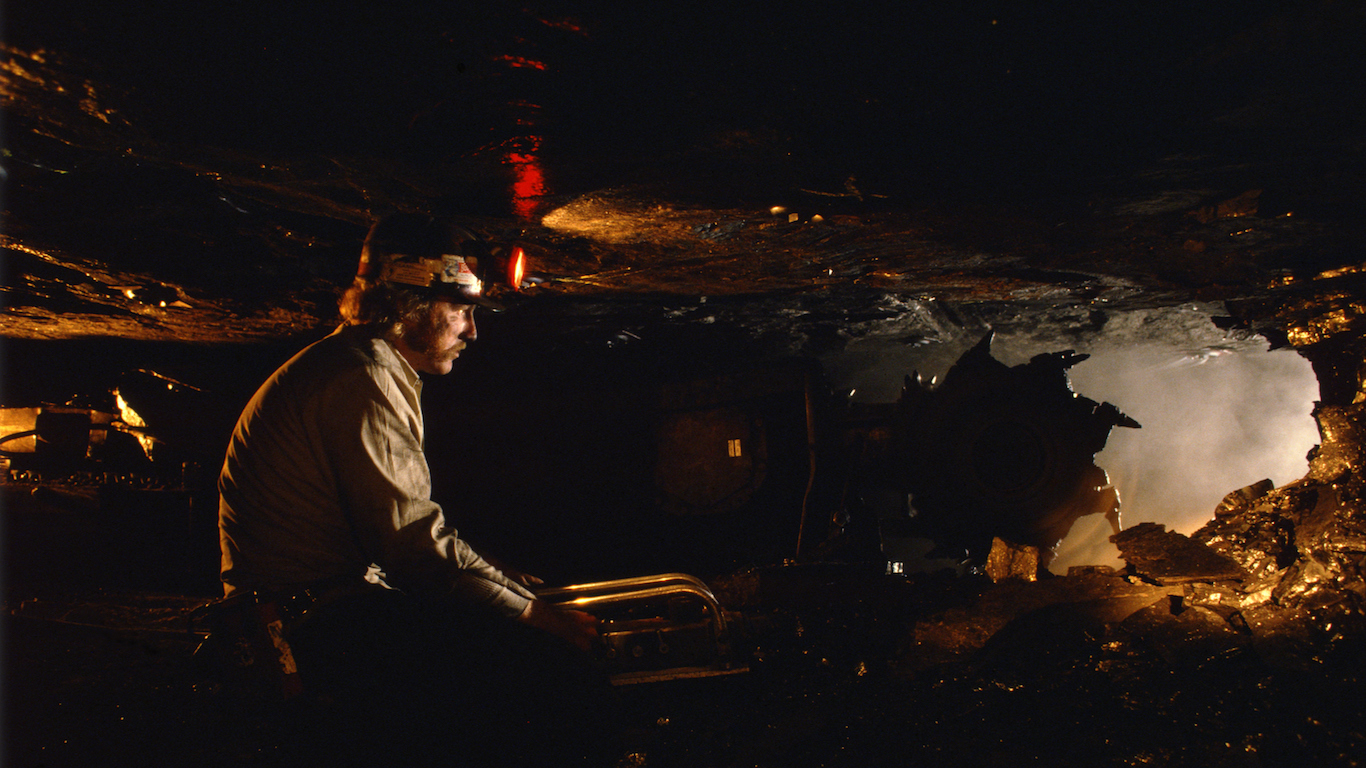
As the economic fallout triggered by the COVID-19 pandemic has demonstrated, feelings of job security are often illusory.
While few could have anticipated the scale of our current jobs crisis, there are certain occupations that, for a variety of reasons unrelated to the pandemic, are becoming increasingly obsolete. Within these jobs, economists predict staggering drops in employment ranging from 20% to over 50% of these occupations’ total workforces in the coming years.
Using data from the Bureau of Labor Statistics’ Employment Projections program, 24/7 Wall St. identified America’s 25 fastest disappearing jobs. Occupations are ranked on the percentage decline in employment from 2018 to 2028. Only occupations at the finest level of detail in the Standard Occupational Classification System were considered. Supplemental data on total employment, educational attainment, and typical education requirements by occupation are also from the BLS EP. Data on median annual wage in 2019 is from the BLS Occupational Employment Statistics program.
Several of the types of occupations on this list, such as those relating to the post office and mail delivery, will likely undergo steep employment declines due to falling demand for these services — as communications are increasingly carried out online. More commonly, the jobs on this list, such as those in the manufacturing sector, are changing due to technological advancements that improve efficiency and reduce the need for human labor. Here is a look at the cities that will lose the most jobs to automation.
The types of jobs that rank on this list also tend to have little in the way of educational requirements. Of 25 jobs on this list, 20 typically require no more than a high school diploma, and three have no formal education requirement. Several are also low paying, with five reporting a median annual wage below $33,500 — for context, the U.S. median annual wage is $39,810 across all occupations. Some, however, have relatively high median salaries. Here is a look at the highest paying jobs you can get without a college degree.
Click here to see America’s 25 disappearing jobs.

25. Postal service mail carriers
> 2018-2028 projected employment change: -19.8% (328,700 to 263,700)
> Typical education needed for entry: High school diploma or equivalent
> Median annual wage: $51,310
With correspondence and communication as well as the transfer of documents increasingly done online, the volume of mail has dramatically fallen in the last two decades. In 2001, the U.S. Postal Service processed nearly 103.7 billion pieces of first class mail. Since then, volume has fallen every year, and as of 2019, the USPS processed just 54.9 billion pieces of first class mail, a low not seen since the 1970s.
Lower volume will likely translate to budget cuts. Employment for mail carriers is projected to decline by 19.8% over the decade between 2018 and 2028.
[in-text-ad]

24. Postal service clerks
> 2018-2028 projected employment change: -19.8% (75,700 to 60,700)
> Typical education needed for entry: High school diploma or equivalent
> Median annual wage: $48,330
Like mail carriers, employment for postal clerks is projected to decline by nearly 20% through 2028. In addition to steady year-over-year declines in mail volume, which will likely cut into the USPS budget, the Postal Service is also increasingly relying on programmable software that is supplanting the jobs of postal clerks. The USPS is also now rivaled by private companies, including UPS and FedEx.

23. Executive secretaries and executive administrative assistants
> 2018-2028 projected employment change: -19.8% (622,500 to 499,400)
> Typical education needed for entry: High school diploma or equivalent
> Median annual wage: $60,890
The number of executive secretaries and administrative assistants working in the U.S. is projected to decline by 19.8%, from 622,500 in 2018 to fewer than 500,000 by 2028. The likely employment decline is attributable to increased reliance on computer software and artificial intelligence that can be leveraged to carry out many tasks that have traditionally been handled by secretaries and assistants, such as scheduling and document preparation.

22. Drilling and boring machine tool setters, operators, and tenders, metal and plastic
> 2018-2028 projected employment change: -20.5% (11,600 to 9,200)
> Typical education needed for entry: High school diploma or equivalent
> Median annual wage: $38,910
Americans working in this occupation operate and set up machines used for drilling and boring into plastic or metal work pieces. Over the decade ending with 2028, the number of people working in the occupation nationwide is projected to decline by 20.5% to just 9,200.
Like so many other jobs on this list, automation is the driving force behind this occupation’s employment decline. Manufacturers are increasingly relying on CNC and other automated, programmable machines to reduce costs.
[in-text-ad-2]

21. Milling and planing machine setters, operators, and tenders, metal and plastic
> 2018-2028 projected employment change: -20.7% (19,800 to 15,700)
> Typical education needed for entry: High school diploma or equivalent
> Median annual wage: $43,210
Americans working in this occupation operate and set up machines used for milling and planing into plastic or metal work pieces. As is the case in professions throughout much of the manufacturing sector, jobs in this occupation are being supplanted by automated and programmable computers and machines. As of 2018, 19,800 Americans were working in this occupation. By 2028, that number is projected to fall to 15,700.
The decline in manufacturing jobs is significant in part because the sector provided middle class wages to Americans at different levels of education. The median annual wage for those working as milling and planing machine setters and operators is $43,210, higher than the median wage of $39,810 across all occupations.

20. Prepress technicians and workers
> 2018-2028 projected employment change: -20.8% (29,900 to 23,700)
> Typical education needed for entry: Postsecondary nondegree award
> Median annual wage: $40,510
Prepress technicians and workers are responsible for formatting and proofing images and texts before publishing, either in digital or print, in industries such as book publishing, newspaper publishing, or advertising. As improvements in technology increase the efficiency of these workers, employment in the field is projected to decline considerably in the coming years. Between 2018 and 2028, the number of Americans working as prepress technicians is projected to drop by 20.8%.
[in-text-ad]

19. Legal secretaries
> 2018-2028 projected employment change: -20.9% (180,100 to 142,500)
> Typical education needed for entry: High school diploma or equivalent
> Median annual wage: $47,300
Legal secretaries act as assistance to attorneys, preparing legal documents and often assisting in research. Between 2018 and 2028, the number of Americans working as legal secretaries is projected to decline by 20.9%. The decline will likely come as improved technology would allow lawyers and paralegals to easily incorporate the duties of legal secretaries.

18. Pressers, textile, garment, and related materials
> 2018-2028 projected employment change: -21.2% (39,900 to 31,400)
> Typical education needed for entry: No formal educational credential
> Median annual wage: $24,190
Pressers straighten and iron clothing and other textiles. As formal office attire like suits becomes less commonly required, the services from pressers are less in demand, and there are projected to be 21.2% fewer pressers in 2028 than there were in 2018.
Like many other disappearing jobs, working as a presser requires no formal education, and just 53.1% of workers in the field have a high school diploma, one of the lowest shares of any job. Career fields with low or no education requirements do not typically pay well, and pressers are no exception — most pressers make less than $24,200 per year.

17. Photographic process workers and processing machine operators
> 2018-2028 projected employment change: -21.3% (17,100 to 13,400)
> Typical education needed for entry: High school diploma or equivalent
> Median annual wage: $32,280
Photographic process workers and processing machine operators typically develop film photographs or edit digital photos. As of 2018, there were 17,100 people working in the occupation in the U.S. By 2028, that number is projected to decline to 13,400. Demand for these workers is projected to fall in the coming years as improved technology increasingly makes it easier for people to edit and print their own photographs.
[in-text-ad-2]

16. Coil winders, tapers, and finishers
> 2018-2028 projected employment change: -21.6% (12,300 to 9,700)
> Typical education needed for entry: High school diploma or equivalent
> Median annual wage: $36,520
Coil winders, tapers, and finishers work with wire coils used in electric equipment. Employment in the field is expected to be impacted by advances in technology that will allow companies to improve output with fewer workers. The increased efficiency is projected to cut the number of Americans working in the occupation from 12,300 in 2018 down to 9,700 from in 2028.

15. Aircraft structure, surfaces, rigging, and systems assemblers
> 2018-2028 projected employment change: -22.0% (45,100 to 35,200)
> Typical education needed for entry: High school diploma or equivalent
> Median annual wage: $54,210
Aircraft structure, surfaces, rigging, and systems assemblers manufacture airplanes or spacecraft and their parts. Like many occupations in the manufacturing sector, aircraft assembly will require fewer laborers in the coming years as technological advancements improve efficiency in production plants. There were 45,100 Americans working in the occupation in 2018. By 2028, that number is projected to fall to 35,200.
[in-text-ad]

14. Data entry keyers
> 2018-2028 projected employment change: -23.2% (187,300 to 143,900)
> Typical education needed for entry: High school diploma or equivalent
> Median annual wage: $33,490
Data entry keyers are typically responsible for inputting data into computer systems and looking for data errors. The decline in demand for the job will be fueled in part by improved software that will be able to automatically input data. Other technological improvements will also increase efficiency of data input, and similar output will be achievable with fewer workers. The number of Americans working as data entry keyers is projected to decline by 23.2% from 2018 to 2028.

13. Postal service mail sorters, processors, and processing machine operators
> 2018-2028 projected employment change: -23.8% (99,700 to 76,000)
> Typical education needed for entry: High school diploma or equivalent
> Median annual wage: $60,140
Postal service mail sorters, processors, and processing machine operators is one of several occupations associated with the USPS to rank on this list. Since peaking in 2001, the volume of first class mail has declined by about 47% in the United States. Additionally, improved technology in sorting machines and mail trackers will continue to supplant the need for workers in this occupation. From 2018 to 2028, the number of Americans employed as mail sorters and processors will decline 23.8%.

12. Switchboard operators, including answering service
> 2018-2028 projected employment change: -23.8% (73,400 to 55,900)
> Typical education needed for entry: High school diploma or equivalent
> Median annual wage: $30,610
Switchboard operators relay calls through telephone systems. There are projected to be 17,500 fewer operators in the U.S. over the next decade as more businesses begin to utilize automated phone systems, video calls, and other alternatives. The median annual wage of switchboard operators is $30,610 — over $9,000 below the overall U.S. median annual wage.
[in-text-ad-2]

11. Computer operators
> 2018-2028 projected employment change: -24.1% (36,800 to 28,000)
> Typical education needed for entry: High school diploma or equivalent
> Median annual wage: N/A
While many jobs involve the use of computers, the computer operator occupation is a specific job that involves monitoring and controlling computer and data processing equipment and responding to error messages. This occupation is quickly becoming a relic of the past, however, as improved technology is automating many duties of computer operators, resulting in reduced need for such workers. Between 2018 and 2028, the number of Americans working in the field will fall by 24.1%.

10. Mine shuttle car operators
> 2018-2028 projected employment change: -25.3% (1,700 to 1,300)
> Typical education needed for entry: No formal educational credential
> Median annual wage: N/A
Shuttle car operators in coal mines are becoming less necessary as the industry is increasingly relying on autonomous vehicles. Coal production is also declining in the U.S. in favor of more environmentally friendly alternatives. Between 2014 and 2019 alone, U.S. coal production fell from about 1 billion short tons to fewer than 750 million. The number of Americans working as mine shuttle car operators in coal mines is projected to fall from 1,700 in 2018 to 1,300 in 2028.
[in-text-ad]

9. Postmasters and mail superintendents
> 2018-2028 projected employment change: -27.5% (13,300 to 9,600)
> Typical education needed for entry: High school diploma or equivalent
> Median annual wage: $76,900
Postmasters and mail superintendents are charged with managing specific post office branches. As post office locations close around the country due to declining in mail volume, there will be a reduced need for postmasters. In 2018, 13,300 Americans were working as postmasters or mail superintendents. That number is projected to decline by 27.5% by 2028.
Most of the jobs that are disappearing are relatively low paying, but postmasters and mail superintendents are a notable exception. The median annual wage for the position is $76,900, more than every other job on this list and nearly double the $39,810 median across all occupations.

8. Cutters and trimmers, hand
> 2018-2028 projected employment change: -28.4% (10,700 to 7,700)
> Typical education needed for entry: No formal educational credential
> Median annual wage: $30,200
Cutters and trimmers use tools to cut items like fabric, glass, rubber, and more. The job is projected to lose over 28% of positions from 2018 to 2028 as machinery gets more precise and efficient.
Most jobs require at least a high school diploma, but cutters, in most cases, do not need any formal education. Just 70.8% of cutters have a high school diploma as compared to 91.6% of all workers. Just 3.4% of those in the occupation have a college degree — less than a 10th of the share of all workers with at least a bachelor’s degree.

7. Telephone operators
> 2018-2028 projected employment change: -28.4% (5,700 to 4,100)
> Typical education needed for entry: High school diploma or equivalent
> Median annual wage: $35,750
Telephone operators assist customers with accessing directories, billing inquiries, and emergency calls. Demand for these workers is projected to decline precipitously in the coming years as companies increasingly rely on automated telephone systems.
Like many jobs on this list, telephone operators are not required to have much in the way of formal education. Only 15.2% of workers in the occupation have a bachelor’s degree or higher.
[in-text-ad-2]

6. Electronic equipment installers and repairers, motor vehicles
> 2018-2028 projected employment change: -28.6% (11,000 to 7,900)
> Typical education needed for entry: High school diploma or equivalent
> Median annual wage: $37,380
Workers who install and repair electrical equipment in motor vehicles — such as audio systems, security systems, or navigation equipment — will be in far less demand in the coming years. Employment in the field is projected to decline by 28.6% over the decade leading up to 2028 as smartphones and factory-installed components make such workers less necessary.

5. Watch repairers
> 2018-2028 projected employment change: -29.6% (3,000 to 2,100)
> Typical education needed for entry: High school diploma or equivalent
> Median annual wage: $42,520
Watch repair is a dying profession in the United States. As smartphones have become ubiquitous — and smartwatches have been increasing in popularity — Americans have become less reliant on traditional watches. The number of people who work in watch repair is projected to fall from 3,000 to just 2,100 from 2018 to 2028.
Though watch repair does not require much in the way of formal education, it is a highly skilled job that requires long-term on-the-job training.
[in-text-ad]

4. Word processors and typists
> 2018-2028 projected employment change: -33.8% (60,400 to 40,000)
> Typical education needed for entry: High school diploma or equivalent
> Median annual wage: $40,340
Typists are in one of just four career fields that are projected to lose over a third of their 2018 employment by 2028 — declining from 60,400 workers in the occupation to 40,000. Typists will not be required in as many offices, as virtually all younger workers coming into the job market are already proficient with computer keyboards and will be able to do their own typing.
Most typists earned more than $40,000 per year in 2019, slightly more than the $39,810 median annual wage across all occupations in the country that year.

3. Parking enforcement workers
> 2018-2028 projected employment change: -36.7% (8,600 to 5,400)
> Typical education needed for entry: High school diploma or equivalent
> Median annual wage: $40,920
Parking enforcement workers patrol an assigned area, such as city streets or public and private parking lots, and issue tickets to illegally parked vehicles. As of 2018, about 8,600 Americans worked in parking enforcement. However, as cities increasingly adopt automated systems such as license plate readers demand for parking enforcement workers will decline. By 2028, the BLS projects there will be only 5,400 Americans working in the occupation.

2. Respiratory therapy technicians
> 2018-2028 projected employment change: -57.5% (9,300 to 3,900)
> Typical education needed for entry: Associate’s degree
> Median annual wage: N/A
There will be fewer than half as many respiratory therapy technicians in 2028 as there were in 2018, according to BLS projections. This career field is projected to decrease largely for technical reasons — those who gain the skills and education needed to provide respiratory care are now credentialed as respiratory therapists, not technicians, so there will be no new technicians entering the labor force.
The number of respiratory therapists was projected to increase sharply in 2018, as health care providers are expected to begin delegating care to specialists from general care physicians. As a result of the COVID-19 pandemic, the need for these therapists has been even greater.

1. Locomotive firers
> 2018-2028 projected employment change: -68.3% (500 to 200)
> Typical education needed for entry: High school diploma or equivalent
> Median annual wage: N/A
Locomotive firers are charged with monitoring instruments on their locomotive to prevent hazards, such as equipment dragging on the track or track obstructions. The occupation is already one of the smallest in the country by total employment with just 500 workers as of 2018. By 2028, employment is projected to decline by 68.3%, the most of any occupation.
As is the case with many jobs on this list, improved technology and automation will make locomotive firers all but obsolete. Positive train control, or PTC, is a system of computers that communicate with each other to make train travel safer. The system is becoming widely used on American railways and is automating many aspects of locomotive firers’ jobs.
Take Charge of Your Retirement: Find the Right Financial Advisor For You in Minutes (Sponsor)
Retirement planning doesn’t have to feel overwhelming. The key is finding professional guidance—and we’ve made it easier than ever for you to connect with the right financial advisor for your unique needs.
Here’s how it works:
1️ Answer a Few Simple Questions
Tell us a bit about your goals and preferences—it only takes a few minutes!
2️ Get Your Top Advisor Matches
This tool matches you with qualified advisors who specialize in helping people like you achieve financial success.
3️ Choose Your Best Fit
Review their profiles, schedule an introductory meeting, and select the advisor who feels right for you.
Why wait? Start building the retirement you’ve always dreamed of. Click here to get started today!
Thank you for reading! Have some feedback for us?
Contact the 24/7 Wall St. editorial team.
 24/7 Wall St.
24/7 Wall St. 24/7 Wall St.
24/7 Wall St.


